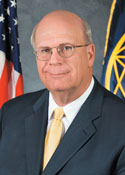It Is All About Integration and Synergy
 |
So often, as we look for the way forward, we are drawn to the topics or solutions of the day—mobility, big data, cybersecurity, the cloud, spectrum management, data center consolidation and network expansion. The fact is that these initiatives are so interdependent that we must look at them together. No one can talk about the use of mobile devices—particularly for government—without dealing with the attendant security issues. No one can talk about pushing large volumes of data to mobile devices without dealing with network expansion and spectrum management. No one can talk about platform independence without addressing use of the cloud. And, no one can talk about building out the cloud without attending to data center consolidation and virtualization.
At the DISA conference, Teri Takai, the Defense Department chief information officer (CIO), led a panel with all the service CIOs. While they are not singing the chorus exactly in tune, they clearly are working together; they all are focused on the enterprise; and they all are attending to the issues just listed.
This is encouraging. The creation of the Joint Information Environment (JIE), still in development, will help further. But some obstacles remain. First, funding and program structures are fragmented. This makes it difficult to apply resources simultaneously to all the elements discussed—especially when design and purchasing is split across multiple services and agencies. Second, not all the services and agencies share exactly the way forward. While for the most part they do share a common vision of the end states, they sometimes see different paths and priorities to arrive there. Putting much of the Defense Department enterprise sourcing and implementation in the hands of DISA will help considerably. The agency is working very hard to address all of these issues, and it is making progress.
DISA is moving forward on key issues such as cloud sourcing and provisioning; mobility solutions and the attendant security; network and data center consolidation; and enterprise services. A good example is implementation of enterprise email. The Army has been the executive agent working with DISA to get enterprise email out to everyone—initially in the Army, then to others. The Joint Staff will join enterprise email soon, followed by the Air Force.
Working enterprise email has brought out a number of issues that had to be solved quickly because they were obstacles to getting email out. Network rationalization, governance, situational awareness and security issues had to be resolved. In addition, identity management and access and global directory compatibility had to be worked and made uniform. The resolution of these problems is bigger than email. Future enterprise services will be easier to implement because these issues are out of the way.
The DISA conference also has seen some excellent industry presentations. Some have acknowledged that, in the past, industry did not always contribute well to integration. Proprietary or fragmented solutions, left to the customer or a third-party service provider to pull together, have slowed progress and often added to total cost. Industry seems to be getting better in offering integrated solutions, but the government is not always good at buying them—or, it wants best-of-breed components from several vendors and has to integrate them itself or pay for this service. Clearly, extensive dialogue is needed among government and industry to address these issues in the most cost-effective way. More use of open architectures and standards and more flexible and innovative licensing agreements would go a long way toward solving the government’s dilemma. Everyone needs to look at the solutions they are providing and ensure they are helping the government meet its needs—not adding to obstacles.
Anyone who missed the DISA Mission Partner Conference missed a great event with a very strong program. Industry should look at what DISA is doing with the Office of the Secretary of Defense and the services with regard to integration and movement to enterprise services. Then, it should look at how it can contribute to this vital and worthwhile effort.



Comments